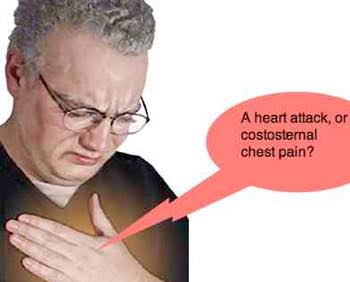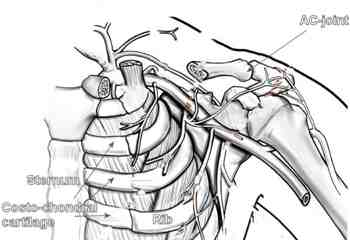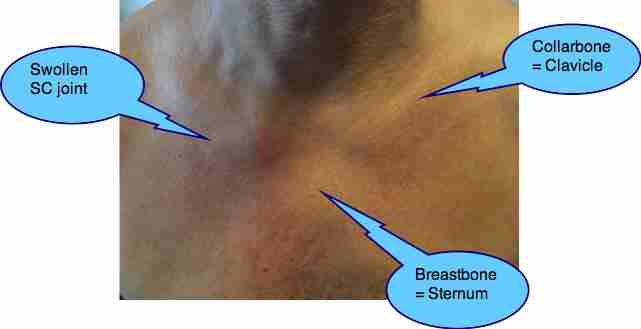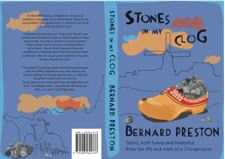Costosternal chest pain
Costosternal chest pain research declares that Tietze's syndrome is the cause of roughly one third of people presenting at the emergency room with a suspected heart attack; a breastbone condition and not cardiovascular at all.
Costosternal pain, in the joint between the rib and the breastbone, is the most common cause of "non-heart" chest pain. Chiropractic treatment is built around a thorough understanding of the anatomy.

This page was last updated by Dr Barrie Lewis on 6 February, 2023.
This is a not atypical story in any chiropractic practice in the Netherlands. Dutch staircases are a menace.
"This morning I fell down the stairs. It happened so suddenly that I do not remember any of it; but as soon as I realized what was happening I felt a sharp pain by the breastbone. All day everything I have done has hurt.
It is painful to breathe, I have a really hard time buttoning up my pants, and bending over to pick anything up is rather difficult. But as far as I know when I fell the only things that touched the ground were my arms, back and legs; and buttocks."
Hello,
One of two things has probably happened; you have either
cracked a rib which is quite likely since taking in a deep breath is painful, or injured the costosternal joint.
The cracked rib, assuming it is an undisplaced fracture, will heal in about a month, with no treatment, grin and bear it. Use ice and do not do the things that cause pain. Do not breathe deeply.
It is
likely to be quite painful for a couple weeks.
An injured
costosternal joint is more difficult, and also often has a
corresponding pain in the midback. It can lead to a distressing
condition called Tietze's syndrome.
You
need to use your common sense. If your gut feeling is that you have had a
serious injury then it is probably best to get an x-ray. If not, use
alternating ice and heat and be careful for a couple days and see what
happens.
If the pain continues, do not leave it. Tietze's syndrome can be murder.
Let us know how you get on.
Dr Barrie Lewis DC
The costo-chondral cartilage (see pic below) is the cause of one third of patients complaining of chest pain in one hospital's heart clinic.
It's the most common cause of non-heart chest pain.
Costosternal chest pain
Costosternal chest pain research declares that Tietze's syndrome is the cause of roughly one third of people presenting at the emergency room with a suspected heart attack.
One of the simplest treatments is cold and hot therapy.
Prevalence
Chest pain is very common and obviously can be serious. However, it usually isn't. The proportion of patients with a condition is called the prevalence. Recent research reveal these interesting facts.
- In the emergency department, approximately 10 to 15 percent of adults and 23% of children presenting with chest pain have a musculoskeletal breastbone condition, like this costosternal syndrome.
- In one large study 11 percent of adults presenting with chest pain were felt to have a costo-sternal cause.
- The incidence rose to 26 percent in those patients considered at low suspicion for myocardial infarction, making this THE MOST COMMON category of non-cardiac chest pain in this setting.
- In an emergency department study of 122 consecutive patients, 30% were felt to have chest wall tenderness due to a costo-sternal syndrome.
In 17, pressure on the rib reproduced their pain.
- However two of these people indeed were having an acute myocardial infarction, indicating that chest wall tenderness
does not exclude the presence of serious coronary disease.
- In a study of 250 patients hospitalized for chest pain, 23% of the non-cardiac patients were felt to have a Costo-sternal musculoskeletal cause.
- In a review of 399 episodes of chest pain evaluated in primary care practice settings, 36 percent were categorized as costo-sternal in origin, making this the most common diagnostic category.
- Could it be a HEART ATTACK?
Chiropractic help
Chiropractic help receives many queries about breastbone discomfort, also known as costosternal chest pain.
Mr Slechtriem is a barge captain ferrying goods along the Rhine to Switzerland from Rotterdam. He consulted me for headaches that plagued him since a childhood fall from a swing.
On further questioning about conditions, he spoke of the frequent debilitating pain in the chest, pointing directly to the costo-sternal joints.
He was clearly a non-heart patient. Young, strong, non-smoker with low blood pressure. In any case he had been medically assessed.
Whilst the condition has not completely abated, he reported that within a month of starting treatment that the pain was at least 80% better. It does rear its ugly head occasionally, but abates now of its own accord.
He comes for management of his chest pain and headaches about once in 6 weeks, which keeps it under control. We are not going to cure him, alas, but he is well pleased.
In an average primary care clinic, at least one third of patients
complaining of chest pain, have this costo-sternal condition. It may progress to Tietze's syndrome.
For more information on heart-related CHEST PAIN read this page.
-
More anecdotes from the CHIROPRACTIC COALFACE.
Tietze's syndrome
Tietze's syndrome is characterised by tenderness and sometimes swelling of the breastbone rib joint, and also that between the clavicle and the sternum.
In anatomical terms it's called costosternal chest pain.
I call it a stage 4 of costosternal chest pain; it can be a very distressing condition that has no acknowledged and scientifically proven treatment; but it responds reasonably well to chiropractic.
Note well that a heavy manipulation in the mid back will aggravate Tietze's syndrome, and in fact the lower grades of costosternal chest pain. The chiropractic adjustment of choice is the anterior thoracic technique.
It occurs not uncommonly after breast surgery and mastectomy causing great distress in the patient who assumes there has been a metastasis to the ribs or lungs. A thorough, careful examination of the whole area is vital to make a speedy diagnosis, because Tietze's syndrome is very treatable with chiropractic; but you are unlikely to be cured, like many medical conditions.
As an aside we should not be too disturbed that our conditions cannot be completely cured; it is just as true of most medical problems.
It is a good reason not to allow conditions to become chronic; for example, research indicates that no matter what treatment you have, after six months of neck pain you have it for life.
That is most likely also true of all our aches and pains. See your local chiropractor for your costosternal chest pain, and make sure that you do it as soon as you realise it is not going to resolve on its own. Certainly do not wait six months, or you may have it for ever.
Our best solution then is an occasional, but regular chiropractic adjustment for your chronic conditions; rather like the diabetic must continue with medical care.
Having said that, with type 2 diabetes the most important treatment is done at home; strictly limiting refined carbohydrate and taking regular short walks after meals to stop spikes in blood glucose. Likewise using ice and gentle massage between the ribs is something you can and must do, daily if necessary.
Breastbone

Costosternal chest pain research declares that breastbone discomfort is the cause of roughly one third of people presenting at the emergency room with a suspected heart attack.

Tidbit
Medical and chiropractic practice often puts doctor and
patient in a compromising situation. If you enjoy reading, you will
certainly love this book, and the chapter where Bernard Preston DC is fired for doing a breast examination on a
patient with Tietze's syndrome. Ultimately it turned out to be a
blessing in disguise.

- Read a few sample chapters from Stones in my Clog by Dr Bernard Preston DC
Useful links - To go from Costosternal chest pain to Rib pain treatment ...
- Hyaline cartilage
- Tietze's syndrome @ Statpearls
When browsing these links use right click and "Open Link in New Tab", or you may get a bad gateway signal.
Did you find this page useful? Then perhaps forward it to a suffering friend. Better still, Tweet or Face Book it.

